
Porta Leoni (Gate of the Lions) is an ancient Roman gate in Verona, northern Italy.
The gate was built during the Roman Republic by P. Valerius, Q. Caecilius, Q. Servilius and P. Cornelius, and restructured in imperial times. It was connected to the road which led to Bologna and Aquileia.

The original Roman name is unknown. During the Middle Ages it was called Porta San Fermo, due to the nearby church, while in the Renaissance it was known as Arco di Valerio. The current name derives from a Roman tomb decorated with two lions (Italian: leoni), now moved near Ponte Navi.[1]
The gate has a square structures, with a double façade and two towers which looked towards the countryside. Now only half of the inner façade, covered with white stone in the imperial age, and the foundings are visible. The original decorations are all lost. The lower part is similar to that of Porta Borsari (also in Verona), while the upper part has an exedra with twisted columns.[2]
See also
[edit]References
[edit]- ^ "Porta Leoni in Verona, Italy". GPSmyCity. Retrieved 2020-12-14.
- ^ Quick, P. S. (2016-06-22). A Guide to Verona: Five Walking Tours. Andrews UK Limited. ISBN 978-1-78538-541-4.
Well, that’s interesting to know that Psilotum nudum are known as whisk ferns. Psilotum nudum is the commoner species of the two. While the P. flaccidum is a rare species and is found in the tropical islands. Both the species are usually epiphytic in habit and grow upon tree ferns. These species may also be terrestrial and grow in humus or in the crevices of the rocks.
View the detailed Guide of Psilotum nudum: Detailed Study Of Psilotum Nudum (Whisk Fern), Classification, Anatomy, Reproduction